The purpose of Piper’s work makes viewers aware of their own racism. She
constructs relationships with the viewers to highlight their xenophobia. While
my work is not as immediate and more specifically addresses ideas surrounding
sexuality and sex, our perspective and intent is similar.
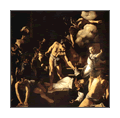  While my ideologies and some working methods parallel both Wojnarowicz and
Piper, aesthetically there are few similarities. Visually I draw from such
artists as Caravaggio and Mapplethorpe, both of whom are used as examples in
Dave Hickey’s The Invisible Dragon: Four Essays on Beauty where he talks
about the idea of transgressive beauty and its “subversive potential” (Hickey,
13). While my ideologies and some working methods parallel both Wojnarowicz and
Piper, aesthetically there are few similarities. Visually I draw from such
artists as Caravaggio and Mapplethorpe, both of whom are used as examples in
Dave Hickey’s The Invisible Dragon: Four Essays on Beauty where he talks
about the idea of transgressive beauty and its “subversive potential” (Hickey,
13).
In my work I look to the gestures, tenebrism, and imagery of Caravaggio. Today
he is seen as a maker of beautiful paintings. However, Hickey argues that during
the time of Caravaggio his works were seen as political due to their subject
matter surrounding the religious debate of intercession.
[W]e must ask
ourselves if Caravaggio’s ‘realism’ would have been so trenchant of his formal
accomplishments so delicately spectacular, had his contemporary political
agenda, under the critical pressure of a rival Church, not seemed so urgent?
(Hickey, 18)
He argues that Caravaggio used aesthetics to lull his viewers into contending
with its subject matter. I draw from this baroque aesthetic in my lighting and
color palette. I want my viewers to be visually seduced by the work and
therefore made to contend with the more socio-political content of the work.
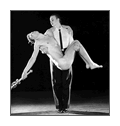  Robert Mapplethorpe used beauty’s inherent visual draw as a means to communicate
ideas of sexuality that run contrary to the mainstream. Hickey argues that the
subject matter alone was not what caused conservative activists of the time to
react so violently, but that he depicted the acts as beautiful. Robert Mapplethorpe used beauty’s inherent visual draw as a means to communicate
ideas of sexuality that run contrary to the mainstream. Hickey argues that the
subject matter alone was not what caused conservative activists of the time to
react so violently, but that he depicted the acts as beautiful.
It was not that men
were making it then, but that Robert [Mapplethorpe] was ‘making it beautiful.’
More precisely, he was appropriating a Baroque vernacular of beauty that
predated and, clearly, outperformed the puritanical canon of visual appeal
espoused by the therapeutic institution (Hickey, 22).
If one represents marginal experiences or people in an unappealing or ugly way
then there is nothing being said that runs contrary to mainstream thought. By
using beauty while photographing queer subject matter one subverts the
mainstream gaze simply by portraying what is widely seen as negative in a
positive light.
Another major aspect to my work is how queerness is manufactured. Michael Warner
claims:
The closet is better understood as the culture’s problem, not the individual’s …
It is experienced by lesbians and gay men as a private, individual problem of
shame and deception. But it is produced by the heteronormative assumptions of
everyday talk. It feels private. But, in an important sense it is publicly
constructed (Warner, 52).
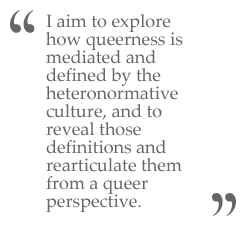 Warner touches upon several main preoccupations in my work. I aim to explore how
queerness is mediated and defined by the heteronormative culture, and to reveal
those definitions and rearticulate them from a queer perspective. I see the body
as the site of mediation between this heteronormative culture and the internal
psyche of the individual. The body, like Warner’s idea of the closet, is
experienced as an individual place of shame and deception, but is ultimately
publicly constructed. In my work, I strive to depict the internal experiences
of heteronormativity on queer bodies. The depiction of this struggle is an
attempt to regain power over the effects of heteronormativity. Warner touches upon several main preoccupations in my work. I aim to explore how
queerness is mediated and defined by the heteronormative culture, and to reveal
those definitions and rearticulate them from a queer perspective. I see the body
as the site of mediation between this heteronormative culture and the internal
psyche of the individual. The body, like Warner’s idea of the closet, is
experienced as an individual place of shame and deception, but is ultimately
publicly constructed. In my work, I strive to depict the internal experiences
of heteronormativity on queer bodies. The depiction of this struggle is an
attempt to regain power over the effects of heteronormativity.
Through this discussion I have put myself in dialogue with some of the key
artists, cultural critics and art theorists that have informed my art making.
From them I have gained a great deal; from Laqueur an understanding of the true
nature of gender, from Wojnarowicz an unapologetically personal approach, from
Piper an embracement of the perspective and experience of being Other, from
Hickey an understanding of the role and power of subversive beauty, from
Caravaggio and Mapplethorpe examples of how to create images of polemical
beauty, from Warner a critical understanding of heteronormativity. In this sense
my work can be considered a branch of the Politics Identity Art Movement. While
I draw from these ideologies, I am moving away from an overtly political stance
to work with an emphasis on cultural commentary in an attempt to make visible
the mechanisms by which people’s experiences are mediated and how they manifest.
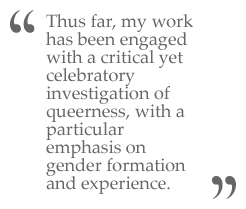 Thus far, my work has been engaged with a critical yet celebratory investigation
of queerness, with a particular emphasis on gender formation and experience.
For me to achieve this, it is crucial that I begin by working from my own
personal experiences in an attempt to transcend the autobiography, without
discounting it. To effectively communicate my ideas I strive for visually
seductive work that contains cultural commentary. Thus far, my work has been engaged with a critical yet celebratory investigation
of queerness, with a particular emphasis on gender formation and experience.
For me to achieve this, it is crucial that I begin by working from my own
personal experiences in an attempt to transcend the autobiography, without
discounting it. To effectively communicate my ideas I strive for visually
seductive work that contains cultural commentary.
I am still fascinated by, and will continue to work with, the mechanisms that
inform gender. However, I have been investigating feminine aspects and
experiences of queer gender. While this is an important aspect to my work, I
have come to the realization that masculinity has an analogous relationship to
the invisible mechanisms that cause systems of oppression. I plan to use this
perspective and to begin investigating masculinity and how it functions in
relationship to queerness... (continue to references)
| 
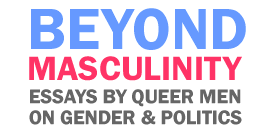


3 COMMENTS ON THIS ESSAY:
I love your art, especially the iconoclast images. Can I find them online elsewhere?
This type of art also highlights the similarities between devotion to religion and devotion to your partner, which I think is closer than a lot of people think.
simply stunning...:)
We are running a short feature of your art on www.redlimemagazine.com until Feb 4th
Your work is beautiful!